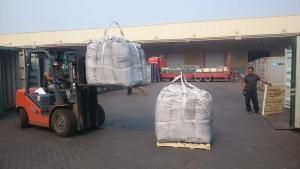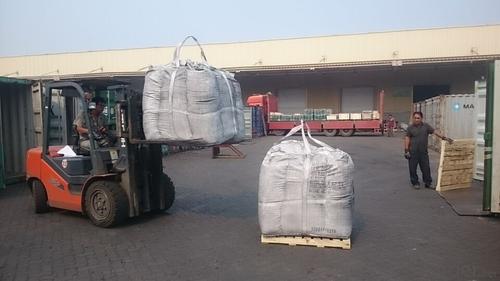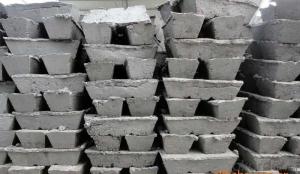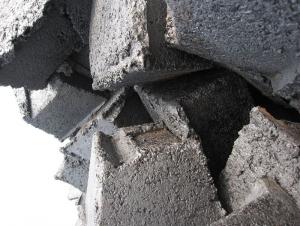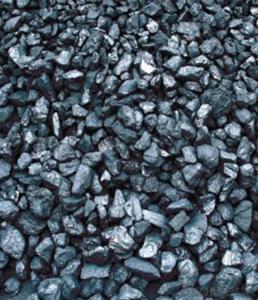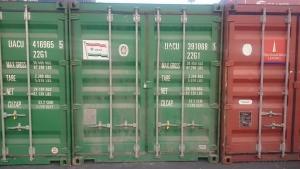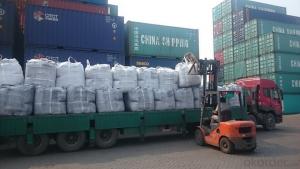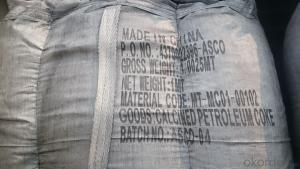Used in EAF as Charge Coke for Steel plants with FC 92%min
- Loading Port:
- Tianjin
- Payment Terms:
- TT OR LC
- Min Order Qty:
- 21 m.t.
- Supply Capability:
- 6000 m.t./month
OKorder Service Pledge
OKorder Financial Service
You Might Also Like
Introduction:
Calcined anthracite can be called carbon additive, carbon raiser, recarburizer, injection coke, charging coke, gas calcined anthracite.
Carbon Additive/Calcined Anthracite Coal may substitute massively refinery coke or graphite. Meanwhile its cost is much less than the refinery coke and graphite. Carbon Additive is mainly used in electric steel ovens, water filtering, rust removal in shipbuilding and production of carbon material.
It has good characteristics with low ash, low resistivity, low sulphur, high carbon and high density. It is the best material for high quality carbon products. It is used as carbon additive in steel industry or fuel.
Features:
Best quality Taixi anthracite as raw materials through high temperature calcined at 800-1200 ℃ by the DC electric calciner with results in eliminating the moisture and volatile matter from Anthracite efficiently, improving the density and the electric conductivity and strengthening the mechanical strength and anti-oxidation, It has good characteristics with low ash, low resistivity, low carbon and high density. It is the best material for high quality carbon products, it is used as carbon additive in steel industry or fuel.
Specifications:
F.C.% | 95MIN | 94MIN | 93MIN | 92MIN | 90MIN | 85MIN | 84MIN |
ASH % | 4MAX | 5MAX | 6 MAX | 6.5MAX | 8.5MAX | 12MAX | 13MAX |
V.M.% | 1 MAX | 1MAX | 1.0MAX | 1.5MAX | 1.5MAX | 3 MAX | 3 MAX |
SULFUR % | 0.3MAX | 0.3MAX | 0.3MAX | 0.35MAX | 0.35MAX | 0.5MAX | 0.5MAX |
MOISTURE % | 0.5MAX | 0.5MAX | 0.5MAX | 0.5MAX | 0.5MAX | 1MAX | 1MAX |
Pictures



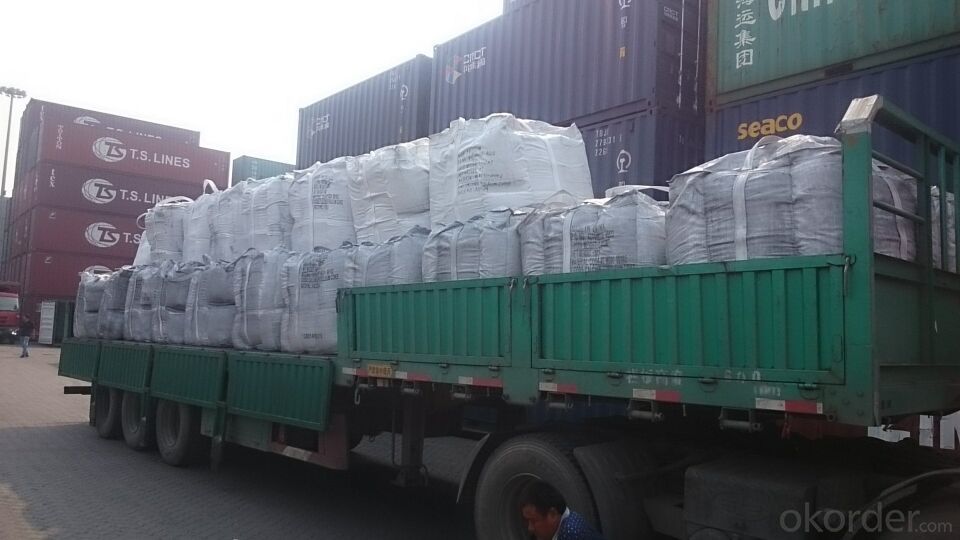
FAQ:
Packing:
(1). Waterproof jumbo bags: 800kgs~1100kgs/ bag according to different grain sizes;
(2). Waterproof PP woven bags / Paper bags: 5kg / 7.5kg / 12.5kg / 20kg / 25kg / 30kg / 50kg small bags;
(3). Small bags into jumbo bags: waterproof PP woven bags / paper bags in 800kg ~1100kg jumbo bags.
Payment terms
20% down payment and 80% against copy of B/L.
Workable LC at sight,
- Q: What are the consequences of increased carbon emissions on public health systems?
- Public health systems are significantly affected by the increase in carbon emissions. One of the main consequences is the worsening of respiratory diseases like asthma, COPD, and bronchitis. These conditions are aggravated by the presence of fine particulate matter (PM2.5) and ground-level ozone, both of which can deeply penetrate the respiratory system. Furthermore, higher levels of carbon emissions are linked to a higher occurrence of cardiovascular diseases. The release of fine particulate matter and other pollutants from carbon-emitting sources can enter the bloodstream, leading to inflammation, oxidative stress, and the development of atherosclerosis. This can eventually result in heart attacks, strokes, and other cardiovascular complications. Additionally, the spread of infectious diseases is also influenced by climate change, which is driven by carbon emissions. The rise in temperatures and changes in precipitation patterns create favorable conditions for disease-carrying vectors like mosquitoes and ticks. This facilitates the transmission of diseases such as malaria, dengue fever, Lyme disease, and Zika virus. Moreover, extreme weather events and natural disasters associated with climate change can disrupt healthcare infrastructure and limit access to essential services, further impacting public health systems. Moreover, mental health is affected by the increase in carbon emissions as well. The degradation of the environment caused by carbon emissions contributes to feelings of anxiety, stress, and depression, often referred to as eco-anxiety or climate grief. The loss of biodiversity, destruction of natural habitats, and the general uncertainty about the future can have harmful effects on individuals and communities, requiring additional resources and support from public health systems. In conclusion, the consequences of increased carbon emissions extend far beyond the environment and have a profound impact on public health systems. They contribute to the prevalence of respiratory and cardiovascular diseases, facilitate the spread of infectious diseases, and affect mental health. It is crucial to address carbon emissions and adopt sustainable practices to mitigate these consequences and protect the well-being of individuals and communities.
- Q: When is gold resistance better? When will carbon resistance be better?
- The gold resistance is of high accuracy, but the price is high. The resistance value of the carbon resistor is low, but it is cheap!
- Q: I want to know why the ATP in the five carbon sugar is a DNA RNA??
- ATP (adenosine-triphosphate) Chinese name three phosphate adenosine, also called ATP (adenosine three phosphate), referred to as ATP, which A said adenosine, T said the number is three, P said that the phosphate group, connecting three phosphate groups.
- Q: What is carbon black filler?
- Carbon black filler is a type of material made from fine particles of carbon that is added to various products, such as rubber, plastics, and inks, to improve their strength, durability, and color.
- Q: How does carbon impact the prevalence of ocean acidification?
- Carbon dioxide (CO2) is a greenhouse gas that contributes to climate change. When excess CO2 is released into the atmosphere through human activities such as burning fossil fuels, a significant portion of it gets absorbed by the oceans. This absorption of CO2 leads to a chemical reaction that increases the concentration of hydrogen ions in the water, resulting in a decrease in pH levels. This process is known as ocean acidification. Carbon dioxide dissolved in seawater creates carbonic acid, which then dissociates into hydrogen ions and bicarbonate ions. The increasing concentration of hydrogen ions decreases the availability of carbonate ions, which are crucial for shell-forming organisms such as corals, mollusks, and some planktonic species. These organisms rely on carbonate ions to build and maintain their shells or skeletons. As ocean acidification progresses, the saturation state of calcium carbonate, a key mineral in shell production, decreases. This makes it more difficult for marine organisms to build their shells, leading to reduced growth rates and weakened structures. Some organisms, such as corals and oysters, may even experience dissolution of their shells under extreme acidification conditions. The impact of ocean acidification extends beyond shell-building organisms. It affects the entire marine ecosystem as it disrupts the delicate balance of various species and their interactions. For example, the reduced availability of carbonate ions can impact the growth and survival of phytoplankton, which form the base of the marine food web. This, in turn, can affect the entire food chain, leading to cascading effects on fish populations and other marine organisms. Furthermore, ocean acidification can also impact the physiological functions of marine organisms, including their reproduction, behavior, and immune systems. Some studies suggest that acidification may impair the ability of certain fish species to detect predators or navigate, making them more vulnerable to predation and reducing their chances of survival. In conclusion, carbon emissions from human activities contribute to the prevalence of ocean acidification. The increased concentration of CO2 in the atmosphere leads to its absorption by the oceans, which subsequently lowers pH levels and reduces the availability of carbonate ions. This process has profound implications for shell-building organisms, the marine food web, and the overall health and biodiversity of our oceans. Addressing carbon emissions and mitigating climate change is essential to reduce the impacts of ocean acidification and preserve the health of marine ecosystems.
- Q: Recently bought an alarm clock, it is recommended to use carbon batteries. Nanfu battery is not good for the movement.
- Carbon batteries are not recommended, and each carbon cell can permanently destroy one cubic meter of soil or more than a dozen cubic meters of water!Today's alkaline batteries are basically mercury free environmentally friendly batteries, which can be thrown away with common waste, with very little environmental damage!What's more, the durability of alkaline batteries is several times that of carbon! Now alkaline battery quality is good, basically will not leak alkaline material!If you think the alkaline battery is not good, it is recommended to use Ni MH rechargeable batteries. The battery is also environmentally friendly and can be recycled for long periods of time,Initial input slightly larger, but if the correct use and charging, cost-effective! Especially for toys with large power consumption!The disadvantage of Ni MH batteries is memory, which needs to be used up and recharged, and is easy to discharge. It loses ten percent of the battery power every monthA few! But now there is a new type of Ni MH rechargeable battery, which is introduced by the manufacturer as if it has a semi discharge of less than fifteen percent and a low memoryOf! More suitable for clocks and watches, remote control, these electrical appliances! What's more, the voltage of Ni MH battery is usually 1.2V, which is lower than that of ordinary dry electricityPond. It is recommended to study the charging, storage and usage of NiMH rechargeable batteries. The correct method of use can save moreMoney, more environmentally friendly!The earth is my home, and it depends on everyone!!
- Q: Why are biological molecules carbon based molecular aggregates?
- Because living things are living organisms, most of them consist of organic compounds, which are carbon compounds, and carbon chains are the main body
- Q: What are the effects of carbon emissions on animal populations?
- Carbon emissions have profound effects on animal populations. One of the main consequences is the disruption of ecosystems and the loss of habitats. As carbon dioxide levels rise in the atmosphere, the Earth's temperature increases, leading to climate change. This change in climate can alter the availability of resources such as food and water, making it more difficult for animals to survive and reproduce. Additionally, carbon emissions contribute to ocean acidification. When carbon dioxide is absorbed by seawater, it reacts with water to form carbonic acid, which lowers the pH of the ocean. This acidification has detrimental effects on marine life, especially on species that rely on calcium carbonate to build their shells or skeletons, such as corals and shellfish. As their habitats become more corrosive, these animals struggle to survive and reproduce, leading to significant declines in their populations. Furthermore, carbon emissions are often associated with air pollution, which has direct and indirect impacts on animal populations. High levels of air pollution, specifically from pollutants like nitrogen dioxide and particulate matter, can cause respiratory problems and other health issues in animals. This can lead to reduced fitness and increased mortality rates, ultimately affecting the overall population size. Lastly, carbon emissions contribute to deforestation and habitat destruction. As more land is cleared for human activities like agriculture or urbanization, animal populations lose their natural habitats and are forced to adapt to fragmented landscapes. This fragmentation restricts their movement, limits access to resources, and increases their vulnerability to predation and other threats. In conclusion, carbon emissions have far-reaching effects on animal populations, including habitat loss, climate change, ocean acidification, air pollution, and deforestation. These impacts disrupt ecosystems and threaten the survival of many animal species. It is crucial to address carbon emissions and reduce our carbon footprint to mitigate these detrimental effects and protect the diversity of life on Earth.
- Q: How does carbon dioxide affect the Earth's atmosphere?
- Carbon dioxide (CO2) affects the Earth's atmosphere in several ways. First and foremost, it is a greenhouse gas, meaning it traps heat from the sun and prevents it from escaping back into space. This process, known as the greenhouse effect, plays a vital role in maintaining Earth's temperature range and making our planet habitable. However, excessive amounts of CO2 in the atmosphere can intensify the greenhouse effect, leading to global warming and climate change. Human activities, such as burning fossil fuels for energy and deforestation, have significantly increased the concentration of CO2 in the atmosphere since the industrial revolution. The increased levels of CO2 contribute to the rising global temperatures, melting polar ice caps, and changing weather patterns. These changes have severe consequences, including more frequent and intense heatwaves, droughts, floods, and storms. Additionally, CO2 absorption by the oceans leads to ocean acidification, which harms marine life and coral reefs. Furthermore, the increase in CO2 levels affects ecosystems and biodiversity. Plants use CO2 during photosynthesis, but excessive amounts can disrupt their growth and alter the balance of ecosystems. This disruption can have cascading effects on other organisms that rely on the affected plant species for food or shelter. Overall, the excess of carbon dioxide in the Earth's atmosphere is contributing to significant environmental changes and poses a threat to the stability of our planet. It is crucial to reduce CO2 emissions, promote sustainable practices, and develop alternative energy sources to mitigate the impacts of climate change and preserve the health of our atmosphere.
- Q: What are the different types of carbon-based air pollutants?
- There are several different types of carbon-based air pollutants that contribute to air pollution. These include: 1. Carbon Monoxide (CO): This is a colorless, odorless gas produced by the incomplete combustion of fossil fuels, such as gasoline, coal, and wood. It is highly toxic and can be harmful to human health, particularly when inhaled in high concentrations. 2. Carbon Dioxide (CO2): This is a greenhouse gas that is naturally present in the Earth's atmosphere. However, human activities such as the burning of fossil fuels and deforestation have significantly increased its levels, leading to climate change and global warming. 3. Volatile Organic Compounds (VOCs): These are organic chemicals that easily vaporize at room temperature. They are released into the air by various sources, including paints, solvents, gasoline, and industrial processes. VOCs contribute to the formation of ground-level ozone, which is a major component of smog and can be harmful to human health. 4. Methane (CH4): This is another greenhouse gas that is primarily produced by the decomposition of organic materials in landfills, as well as the extraction and transportation of natural gas. Methane is a potent greenhouse gas, with a much higher warming potential than carbon dioxide. 5. Polycyclic Aromatic Hydrocarbons (PAHs): These are a group of chemicals that are formed during the incomplete combustion of organic materials, such as coal, oil, and gas. PAHs are released into the air through vehicle exhaust, industrial processes, and the burning of fossil fuels. They are known to be carcinogenic and can have harmful effects on human health. 6. Formaldehyde (HCHO): This is a colorless gas that is used in the production of resins and plastics, as well as in some building materials and household products. It is released into the air through the burning of fuels, cigarette smoke, and the off-gassing of certain products. Formaldehyde is a known respiratory irritant and can cause allergic reactions and other health issues. These are just some of the carbon-based air pollutants that contribute to air pollution. It is important to reduce emissions of these pollutants through the use of cleaner technologies, energy-efficient practices, and the promotion of renewable energy sources to mitigate their negative impacts on both human health and the environment.
Send your message to us
Used in EAF as Charge Coke for Steel plants with FC 92%min
- Loading Port:
- Tianjin
- Payment Terms:
- TT OR LC
- Min Order Qty:
- 21 m.t.
- Supply Capability:
- 6000 m.t./month
OKorder Service Pledge
OKorder Financial Service
Similar products
Hot products
Hot Searches
